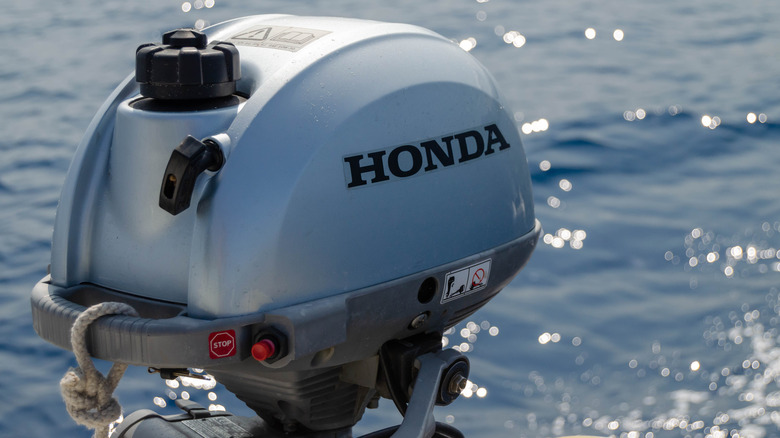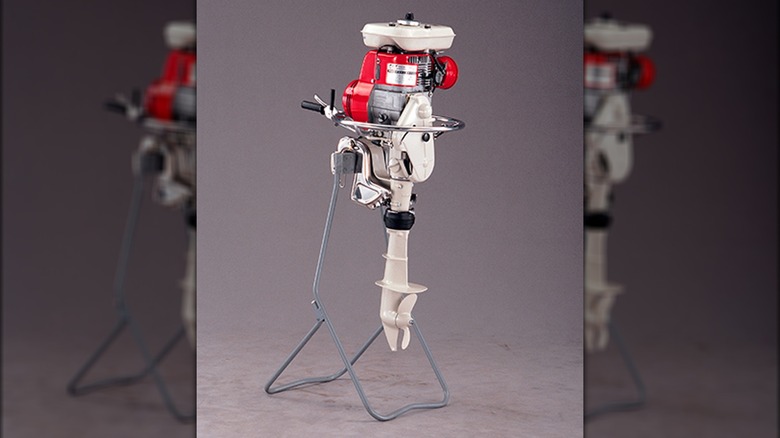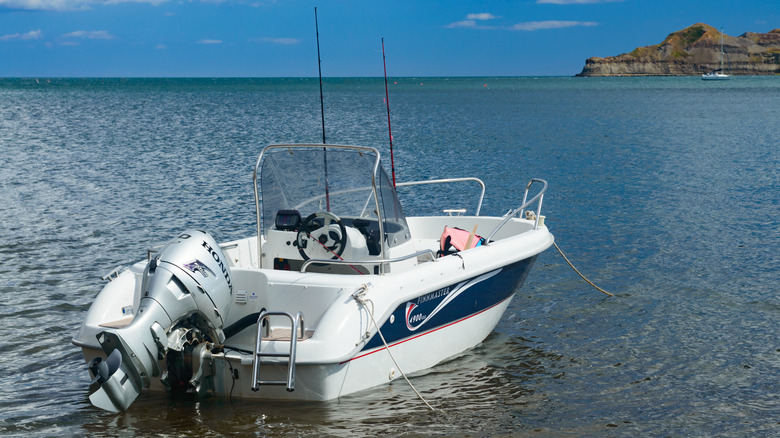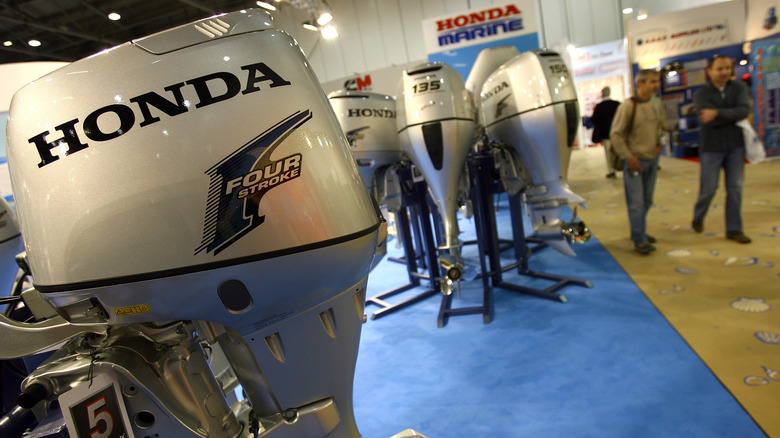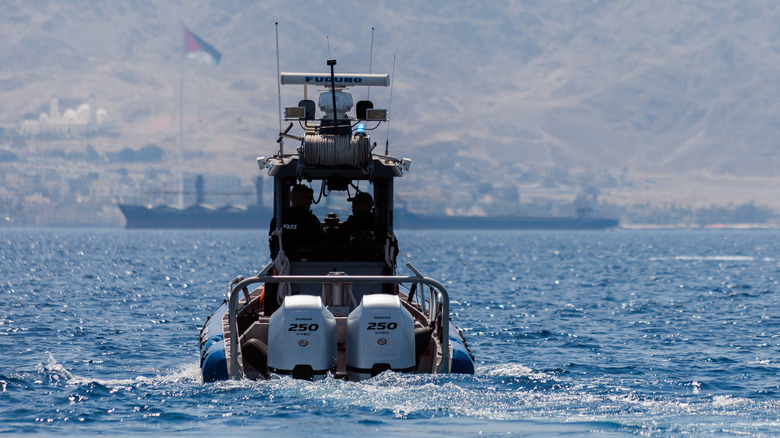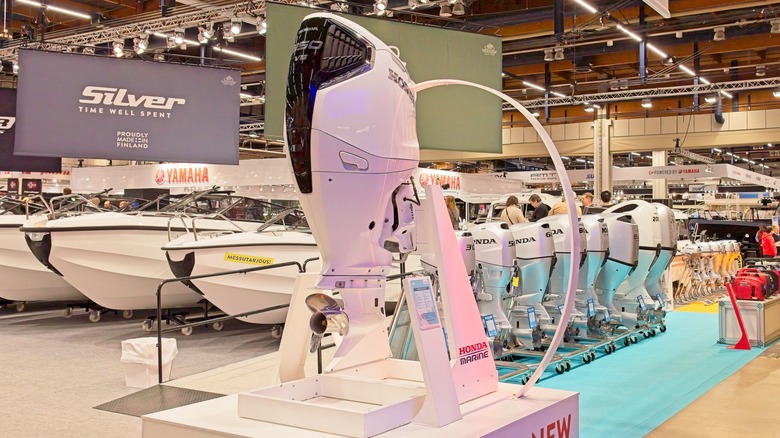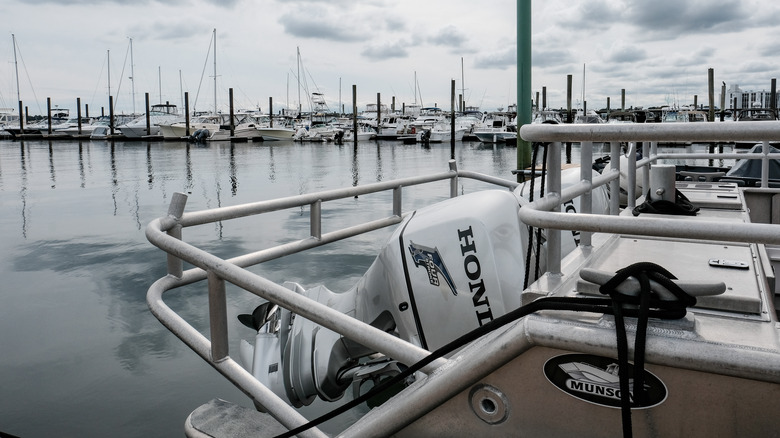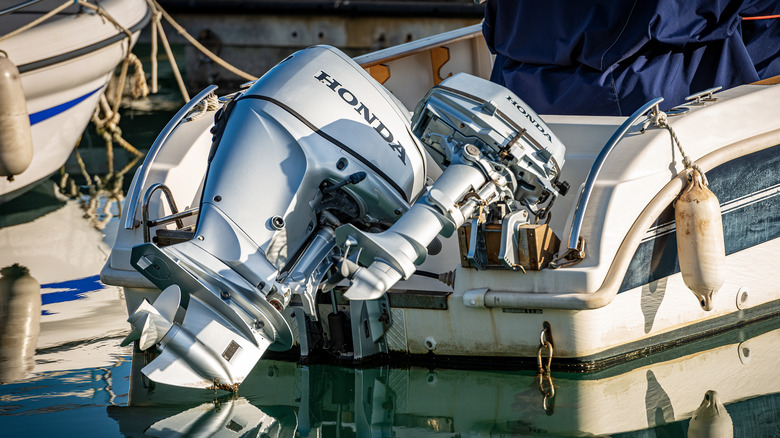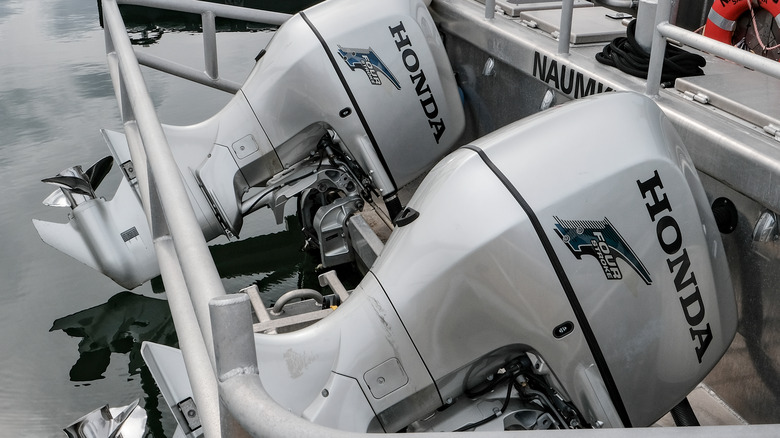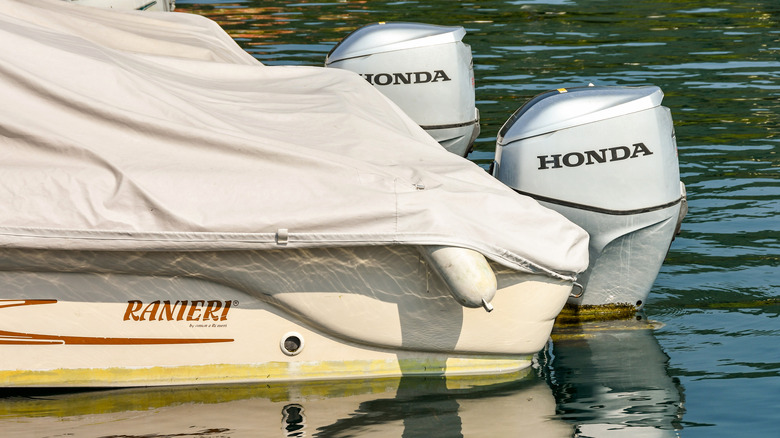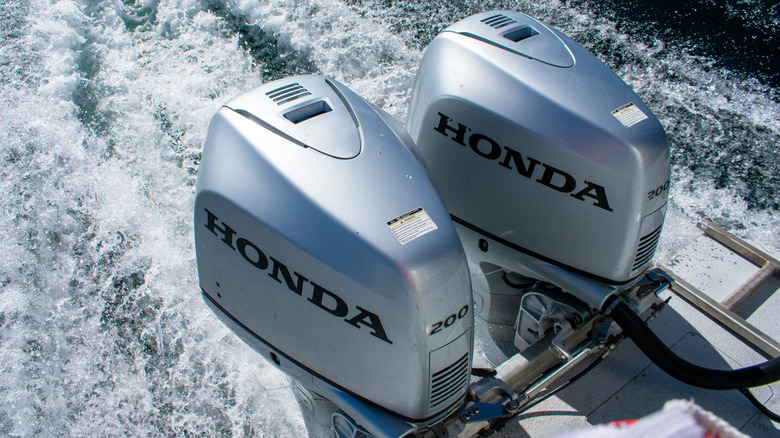Everything To Know About Honda's Marine Engines
Unlike most vehicles, commercial boats can be considered a "power source sold separately" mode of transportation. Smaller boats such as canoes mostly use paddles, but anything larger requires an outboard motor — also known as a marine engine — that isn't always included in the price tag. Plenty of motor companies such as Yamaha produce their own lines of boat motors, but if you're looking for some of the strongest and most reliable motors, you'll probably go for a Honda.
Honda's line of boat engines belongs to the company's Honda Marine product catalog. Aside from the aforementioned motors, Honda also offers boats, propellers for engines, and accessories such as conversion and charging kits. As previously stated, Honda marine engines are only one brand in a sea of outboard motors — pun definitely intended — so why should you pick a Honda over a Suzuki or a Mercury? Well that's what we're here to discuss.
If you're thinking of buying a Honda marine engine (or any outboard motor for that matter), we'll cover the brand's history and some reasons why you might want to favor a Honda over one of its competitors.
The brand started in 1964
The Honda Motor Company was founded in 1948 by Soichiro Honda and Takeo Fujisawa in Hamamatsu, Japan. The organization's first products consisted of bicycle auxiliary engines, but Honda eventually branched out to different countries and motor industries, one of which consisted of boat motors — sort of.
Honda offered its first outboard motor starting in 1964, This engine, the GB30, was simple in design but differed from other marine engines because it technically wasn't one, as the GB30 was actually an industrial engine. This motor was originally designed for the agricultural sector, but Honda retrofitted it with small-scale Japanese fishermen in mind to help them navigate Japan's rivers and lakes. The chief design principle of the GB30 and all subsequent Honda marine engines can be summed up by quoting Soichiro Honda when he said simply, "Mobility on the water should not pollute the water."
Still, the GB30 delivered 2.5 horsepower without requiring too much fuel, and the engine was relatively quiet, to boot. As time went on, Honda Marine started producing actual outboard motors that weren't repurposed tractor engines. While the GB30 couldn't handle the rough-and-tumble waves of the ocean, its successors could. In 1967, Honda started selling marine engines to U.S. customers, and these products are currently some of the most popular outboard motors available stateside.
Honda offers four sizes of engines
Boats come in different sizes, and this means that they need different sizes of outboard motors. If the engine is too small, your boat won't go anywhere, but if the engine is too big you could lose control. Thankfully, Honda offers plenty of engines that cater to different needs and commercial boats.
Honda sells engines in four different sizes – portable, mid-range, high power, and jet drive. The Portable line consists of lightweight motors designed for dinghies and johnboats. Depending on the model, these motors can boast anywhere between 57.2 to 350 cc of displacement and 2.3 to 20 horsepower. The mid-range engines, meanwhile, are the next step up in power. These engines are good for skiffs, flat boats, pontoons, and smaller fishing boats, and they provide anywhere between 552 to 1,496 cc of displacement and 25 to 100 horsepower.
The high power engines are where things start to get really juicy. While prior engines are ideal for shallow waters, High Power models are meant for oceanic locations and work best with charter boats, fishing boats, and even government vessels. These engines provide anywhere from 2,345 to 4,952 cc of displacement and between 115 and 350 horsepower. Finally, there's the jet drive engines. These motors fit all the boats that accept high power engines while offering between 998 to 2,354 cc of displacement and from 40 to 105 horsepower.
What sets Honda marine engines apart from others
To cut down on manufacturing and weight, many engine producers have built outboard motors as two-stroke engines. However, those kinds of devices are inefficient and prone to excessive pollution, so companies have started manufacturing four-stroke outboard motors. Honda is not one of those companies because it doesn't need to catch up with the times — it was ahead of them all along.
Even though Honda Marine's first engine, the GB30, was nothing more than a repurposed agricultural engine, it was still a four-stroke engine. This gives Honda the honor of offering the first four-stroke outboard motor. When Honda started selling these engines in foreign markets such as the United States, they were usually the first four-stroke outboards to hit their respective overseas markets. In 1985, Honda was also the first company to provide a full line of four-stroke outboard motors.
Thanks to their four-stroke designs, Honda marine motors were more fuel efficient and ran cooler than their main rivals. In fact, Honda outboards were so efficient that starting in 2005, every model either met or exceeded the Environmental Protection Agency (EPA)'s emission standards. This means the company also manufactured the first outboard motors to ever exceed EPA emission guidelines. In addition, starting in 2008 Honda marine engines earned three-star ratings from the California Air Resources Board (CARB), which is impressive since that state has some of the strictest air quality laws in the United States.
Honda has won numerous awards for its engines
While not a foolproof metric, you can usually judge the quality of a product by the number of awards it or its manufacture has won. Razzies notwithstanding, the more the merrier. This rule can apply to cars, movies, video games, and even outboard motors.
Honda Marine's earliest awards were for its engine design prototypes. The company has won the IMTEC Innovation Award for the BF45 and BF90 motors, the latter of which also received Popular Mechanics' Design and Engineering Award in 1995. Later, Honda won the IBEX Innovation Award (the successor to the IMTEC Innovation Award) in 2011 and 2016 for the BF250 and BF6 engines, respectively.
While Honda received several awards for its motors, its most reliable recognitions are in the customer service front. Starting in 2004, Honda Marine got the Customer Service Award from the National Marine Manufacturers Association (NMMA), and as of 2023, the NMMA has given Honda Marine the same award for 21 years running. This might explain why many local and federal government agencies rely on Honda Marine engines — they run smoothly most of the time, and when they don't, Honda's there to make 'em work.
Of course, Honda also offers a five-year warranty on all of its outboard engines, regardless of who buys it, so that probably bumped the company up a few positions in the NMMA Customer Service rankings.
Honda didn't make V8 engines before its marine motors
V8 engines are some of the most sought-after motors in the auto industry. If you own a car with one, you own a powerhouse and collector's item rolled into one. Honda never bothered constructing any commercially available V8s until the early 2020s, but even then the engines were not designed for their cars.
Honda currently only makes one V8 engine – the BF350. The final offering in Honda's High Power line, this engine is the most powerful outboard motor in Honda Marine's product catalog. While V8 engines aren't known for their fuel efficiency, the BF350 is supposed to run longer than many other outboards. Moreover, Honda designed the engine to run on regular gas, which is a rarity among V8 engines and lets owners save on refueling costs.
The BF350 went on sale in 2023, almost a full 60 years after Honda Marine was founded and almost 100 years after the V8 engine was invented. While Honda once offered a car that included a V8 engine that predated the BF350, the Honda Crossroad, that SUV used a non-Honda V8 -– a 3.9 L Rover to be precise. Since the BF350 is Honda's first true stab at V8 engines, only time will tell if the company adapts the technology for its cars, keep V8s restricted to marine engines, or limits the V8 to a one-off experiment.
Fuel efficiency is built into many marine engine technologies
Motor manufacturers should always strive for fuel efficiency. After all, we have only so much crude oil on the planet. Fuel efficiency is literally built into the DNA of every Honda Marine engine, almost to the point of redundancy.
Many of Honda Marine's engines utilize at least one form of technology designed to help users save gas. One such system is Honda's Variable Valve Timing & Lift Electronic Control (VTEC), which alternates the lift and duration of intake valves depending on an engine's speed to maximize power and torque. Another common proprietary technology is Boosted Low Speed Torque (BLAST), which opens up the throttle quickly and improves the air-fuel ratio and ignition timing to maximize the engine's power. Depending on the mode, Honda's marine engines can also include power thrust, dual stage induction, and lean burn control systems.
One might wonder how these features improve a Honda outboard motor's fuel efficiency since they are seemingly more designed to let users floor it, which normally wastes gas. The answer is a term of art that every boater worth their salt knows — getting on plane. This occurs when a boat's lift increases to a point where it rides over its bow wave. Not only does getting on plane improve a boat's stability, but it also reduces drag, which means the engine will require less gas to maintain this speed and performance. Yes, a Honda engine might use more fuel to get on plane faster, but that sacrifice saves gas in the long run.
Many motors integrate with other systems
Interconnectivity is a main feature of modern technology. You can use a phone to control everything from your air conditioning to your PlayStation, and Honda offers similar services. Your phone can act like a digital key for certain Honda cars, and Honda Marine's motors can sync up with other boat-based devices.
With the exception of Honda Marine's portable line of engines as well as the mid-range BF25 and BF30 models, all of the company's outboard motors include NMEA 2000 functionality. This system is a communication protocol that utilizes Controller Area Network (CAN) tech. Originally, CAN technology was designed for automobiles, but NMEA helped it find a second home in marine engines.
While the NMEA 2000 lets many Honda motors communicate with GPS and sonar devices, the protocol wasn't designed by Honda. The system's name is partially formed out of the acronym of the organization that created it — the National Marine Electronics Association. The NMEA 2000 was built with universal communication in mind, so you can use sonar, GPS, and other nautical devices developed by companies such as Garmin, Navico, and Molex. However, you need to wire everything together with an NMEA 2000 kit or purchase a boat with NMEA 2000 wiring pre-installed before the devices will communicate.
Many engines feature plug-and-play technology
When you think of outboard motors, the image of an engine controlled by a stick probably comes to mind. Honda Marine's smaller marine engines provide this control method, but if you get anything bigger than their smallest engines, you need a different system that the company gladly provides.
While NMEA 2000 is technically a plug-and-play technology that lets Honda marine engines communicate with other devices, the company offers another plug-and-play system exclusive to its motors – Intelligent Shift & Throttle (IST). This protocol is primarily designed for boats with more than one Honda motor. Once they are hooked up, you can control both engines simultaneously. IST also lets you alter each engine's trim position as needed.
Even though IST is primarily designed for syncing up Honda engines, that's only part of the system's functions. IST also offers support for third-party controls such as SeaStar Solutions' Optimus 360 Joystick. Moreover, IST has theft-deterrent systems and superior docking controls that are improved even more when paired with the aforementioned joystick. In addition, IST technically utilizes NMEA 2000, which means it works with the SeaStar Solutions SeaStation GPS system. What's so important about this particular GPS? It can automatically tether a boat to a set location so you can fish in your favorite spot without worrying about drifting away.
Honda marine engines are easy to maintain
Maintenance is a crucial part of owning an engine, perhaps more so with outboard motors. If your engine breaks down in the middle of an ocean or lake, you can't exactly call AAA and expect them to tow your boat to a shop. However, Honda Marine's engines are so easy to maintain that you can DIY the process no matter your level of engine expertise.
Honda Marine engines have a huge advantage compared to other outboard motors thanks to four-stroke design. Granted, four-strokes are expensive to maintain because they have more moving parts, but by that same token, they require maintenance less often. When you need to work on your Honda outboard, you can usually start by easily unclasping the top.
Many Honda Marine engines contain features that make maintenance even easier than it already is. For instance the BF2.3 model utilizes a carburetor drain screw to quickly empty out the float bowl, and draining oil is designed to be as easy as filling it. Meanwhile, the BF 20, 30, and 50 cut down on maintenance time and cost by including side-mounted oil filters and screw-type valve adjusters. Ease of maintenance, especially when it comes to oil and filter changes, is a selling point for most if not all Honda outboard motors.
Honda offers several tools to help new users
If you're new to marine engines -– which you probably are if you're reading this article –- you probably need all the help you can get. An article like this can only get you so far. Even if you know what engine you want or need, how do you know what propeller will go with it? Can you even afford the engine? Honda Marine can throw you a few bones in these regards.
The first and most important tool Honda offers is a prop calculator built into its website. To start, select between eight different types of boat hulls, six performance goals (e.g., general purpose, racing, or fuel economy), and the various Honda Marine engines. Then select whether you will use one or two engines and your boat's performance and weight, and the calculator will provide the best prop to go with your engine of choice.
Honda also provides financing options to help make outboards more affordable. Currently, the company provides a 3.99% financing plan on outboard motors, but visitors can also find a 5.99% and 7.24% financing plan from Sheffield Financial. However, those are just the offers available on the Honda website. The company also has financing promotions available through various dealers, but in order to find which ones are near you, you have to search for them through the Honda website.
